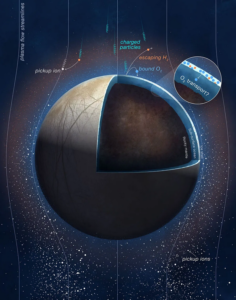NASA’s Juno mission has measured the rate of oxygen production on Jupiter’s moon, Europa, unlocking new insights into the search for extraterrestrial life. According to NASA, the ice-covered moon generates around 1,000 tons of oxygen every day, sufficient to support a million humans’ daily breathing needs. However, new findings imply that there might be still less oxygen than previously believed.
Europa’s orbit around Jupiter forms a crucial element of this discovery. As the moon is situated in the midst of Jupiter’s radiation belts, ionized particles from the gas giant continuously bombard Europa’s icy surface, leading to the generation of oxygen. As JADE scientist Jamey Szalay put it, “When these ionized particles impact Europa, they break up the water-ice molecule by molecule on the surface to produce hydrogen and oxygen. The entire ice shell is being continuously eroded by waves of charged particles washing up upon it.”
On September 29, 2022, Juno flew within 220 miles of Europa, enabling JADE to measure the hydrogen and oxygen ions generated by the impacted charged particles and picked up by Jupiter’s magnetic field as it swept past the moon. Scott Bolton, Juno’s principal investigator, noted that Juno’s observations have lent a tight constraint on the amount of oxygen produced on Europa’s icy surface.
The findings throw a new light on the hopes of life on Europa. Previous telescope-based observations and studies projected a higher concentration of oxygen in Europa’s ice. However, the new research published in Nature Astronomy indicates a significantly narrower range to support habitation, contradicting earlier assumptions and suggesting a lower oxygen level.
These findings are based on data collected by NASA’s Juno spacecraft during a close flyby of Europa in 2022. A US-European team calculated that between 13 and 39lbs of oxygen are produced at Europa’s surface every second. The researchers concluded, “Unless Europa’s oxygen production was significantly higher in the past, these new measurements provide a narrower range to support habitability”.
Lead author James Szalay stated, “While it’s a significantly narrower range than we previously thought, there’s still a lot we can learn.” Whether this oxygen permeates into the moon’s atmosphere, remains in the ice, or filters down to the presumed underground ocean, remains an enigma.
Although Europa’s potential for life might seem diminished, further research is set to be conducted by NASA’s Europa Clipper mission, launching in the autumn of 2024, providing further data on Europa’s potential to support life.
Information Box:
– Oxygen is derived from intense radiation that bombards Europa’s icy surface, splitting water molecules into hydrogen and oxygen atoms.
– The rate of oxygen production has been now calculated to be around 26 pounds per second, a significant decrease from previous estimates.
– Views on habitability of Europa are divided due to uncertainty of the amount of produced oxygen that might find its way into the subterranean ocean.
– Further investigations will be conducted by NASA’s Clipper mission set to launch in the autumn of 2024.

References:
1: “NASA’s Juno Mission Measures Oxygen Production at Europa”, NASA.
2: “Setback for hopes of life as Nasa says less oxygen on Jupiter moon than thought”, The Guardian.
3: “Europa may have less oxygen to fuel life in its seas than we thought”, New Scientist.

